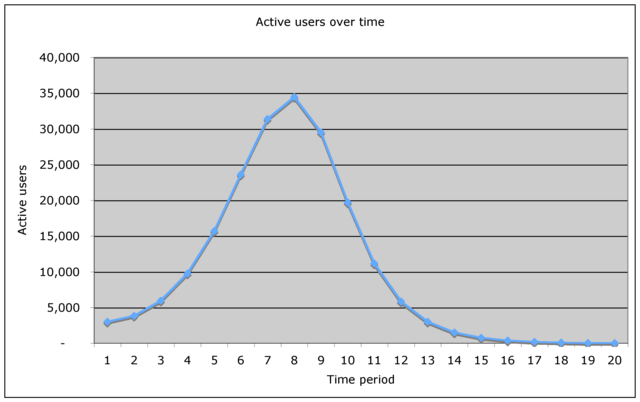Growth II: Building a Product-Driven Growth Machine
Episode #5 of the course The crash course guide to starting up by Alex Schiff
Hi all,
Today, we’re going to talk about engineering “viral growth” into your product, such that each new user acquires additional users through their usage. Viral growth is by no means the only way to achieve large-scale distribution and it is amongst the most difficult to make work, but it is also one of the most scalable and cheapest methods available if you can.
What Is Viral Growth?
When most people think of “viral growth,” they think of widespread discussion on social media, appearances on TV, and a “hockey stick” graph of new users.

(X-Axis = Time Period)
Unfortunately, more often than not, this kind of “virality” ends up looking more like a shark fin.

Graph courtesy of this blog post from Andrew Chen
The reality of virality is much less flashy: It simply means that your product naturally spreads from one user to the next without you having to acquire every new user independently. One way to measure that is with your “k-factor,” or “viral coefficient,” which is the number of users each new user brings in through their use of the product. A product with a very low-factor (like 0.1) does not spread on its own—a “virally acquired” new user is acquired only for every 10 sign-ups. A product with a very high k-factor (like 1.2) will spread very quickly because every single user you attract will bring in more than one additional user.
Designing Virality
For most products, this kind of “virality” is sought by brute force: You’re asked to invite all your friends when you download your app, or to connect your social accounts and share your usage on Facebook. The first, most important rule of virality—the one thing I ask you to take away if nothing else sticks from this module—is that nobody invites people to your product or service just because they think it’s cool. Word of mouth certainly exists, but it’s typically outside of the app invite system.
The second rule of virality is that your chief aim is maximizing the organic touch points between your users and non-users through their natural use of the product.
1. Do your users create content? Give them ways to share on their existing social networks or email, with a link back to your app.
2. Do your users work together on content? Give them ways to send that content to non-users via email in a usable format, inviting them to edit.
3. Do your users use the product with other people? Ask them directly with whom they do the desired activity.
The way to grow virally is to make it as easy, natural, and useful as possible for your users to spread the content they create within your product outside its walls. This can take an infinite number of forms—and usually does require a ton of experimentation—but it relies on having a very precise and fundamental knowledge of who your customer is, why they are using your product, and why they would find it valuable to use with another human being.
As an example, Fetchnotes asked directly after download: “Who do you <activity> with?” (see the image below), and ~20% of our sign-ups invited additional users.

While prompts for mass invites tend to be very ineffective, don’t be afraid to make a targeted ask after a user has achieved success with your product. As with other areas, you’ll often be surprised at what happens if you simply ask:
“Hi there! We’re ecstatic to see you’ve been using the product so much. One quick request: Is there any one person you can think of who might also benefit from our product? Just reply with their email and we’ll send them a personalized note—don’t worry, this is the only email we’ll ever send to them.”
And remember: Sustainable growth is not easy, and it requires focus that you can only get by dividing and conquering.
Tomorrow, we’ll discuss your options for building a team that allows you to do more together than you could ever do on your own.
Onward!
Alex
Recommended reading
Lessons Learned—Viral Marketing
Recommended book
Growth Hacker Marketing: A Primer on the Future of PR, Marketing, and Advertising by Ryan Holiday
Share with friends

